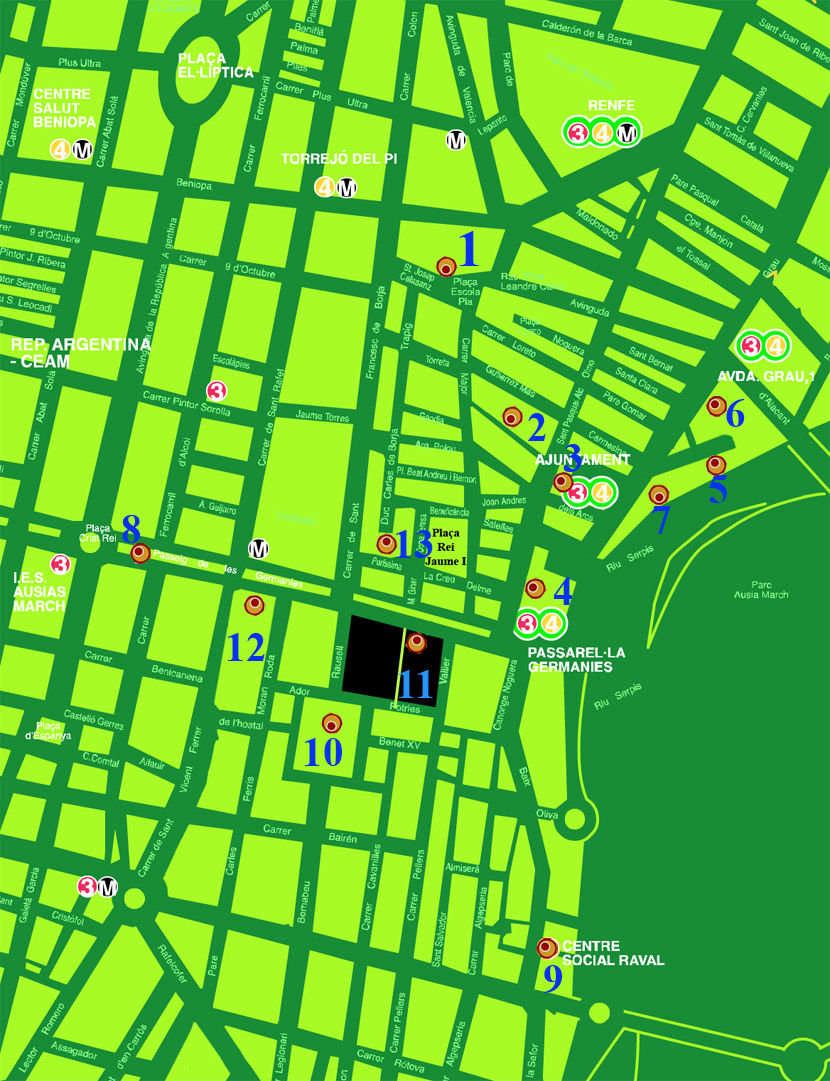
MAIN PLACES OF INTEREST

Click here to increase size
1.-Old University
As well as the Scolapian Fathers school, the building currently houses the Coll Alas art gallery and the National Open University (UNED).
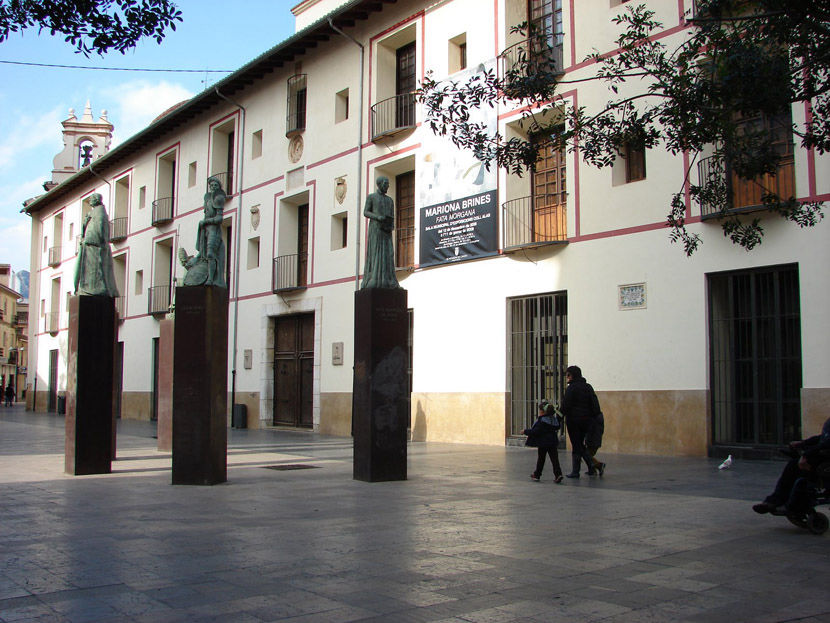
It was created by the fourth duke, Francisco de Borja. In 1550, it became a university, the first Jesuit University in the world. It is a great Renaissance building constructed around a central courtyard. After the Jesuits were expelled it was closed in 1772. In 1806, the Scolapian Fathers bought the building and made it a school. The church was built following the architectural model of the Gesù Church of Rome, promoted by Francisco de Borja. Next to the old university five bronze sculptures, work of the sculptor Manuel Boix, correspond to the five best known members of the Borja/Borgia: the Popes Calixtus III and Alexander VI; Cesare and Lucrecia Borja, and Saint Francisco de Borja.
2.-Santa María Church
This solid temple you can visit with the audioguide is an example of the Catalan-Aragonese gothic style. It consists of a single nave with small side chapels. Its interior was richly decorated with altarpieces, paintings and sculptures, but all disappeared.
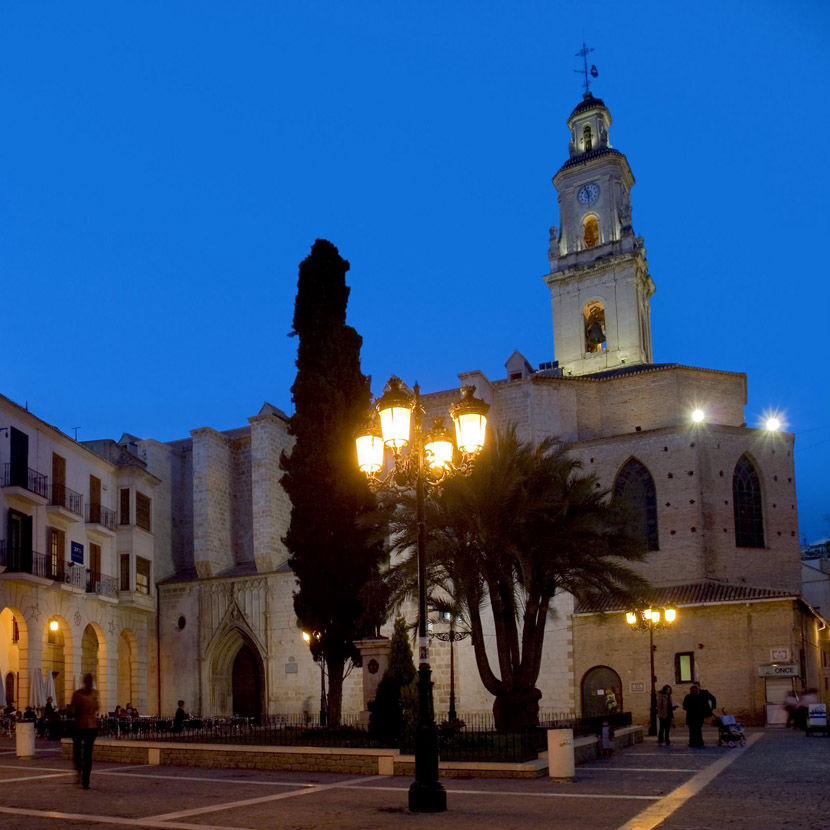
It was built between the 14th and 16th centuries in two phases. The first, commissioned by the royal duke Alfons el Vell and his son, Alfons el Jove, looks on to the Plaça Major. The door, with a lancet arch, is crowned by the image of Santa María. The second phase goes from the door of Santa María to that of the apostles. It was commissioned by María Enríquez, first Borgia duchess of Gandia. In the second phase, the gothic style is more mature and simpler and announces the Renaissance. The duchess commissioned the main altarpiece to the Renaissance painter Paolo da Sanleocadio.
3.-Town hall
The building you are looking at with the audioguide was totally renovated in 1982, preserving only the facade from the 18th century. In 1778, during the reign of Charles III, the New Town Hall was built. Its facade, in neo-Classical style, is the work of Vicente Gascó. From the top balustrade, four busts keep watch. They represent the four cardinal virtues that every good politician must fulfil: prudence, temperance, justice and fortitude..
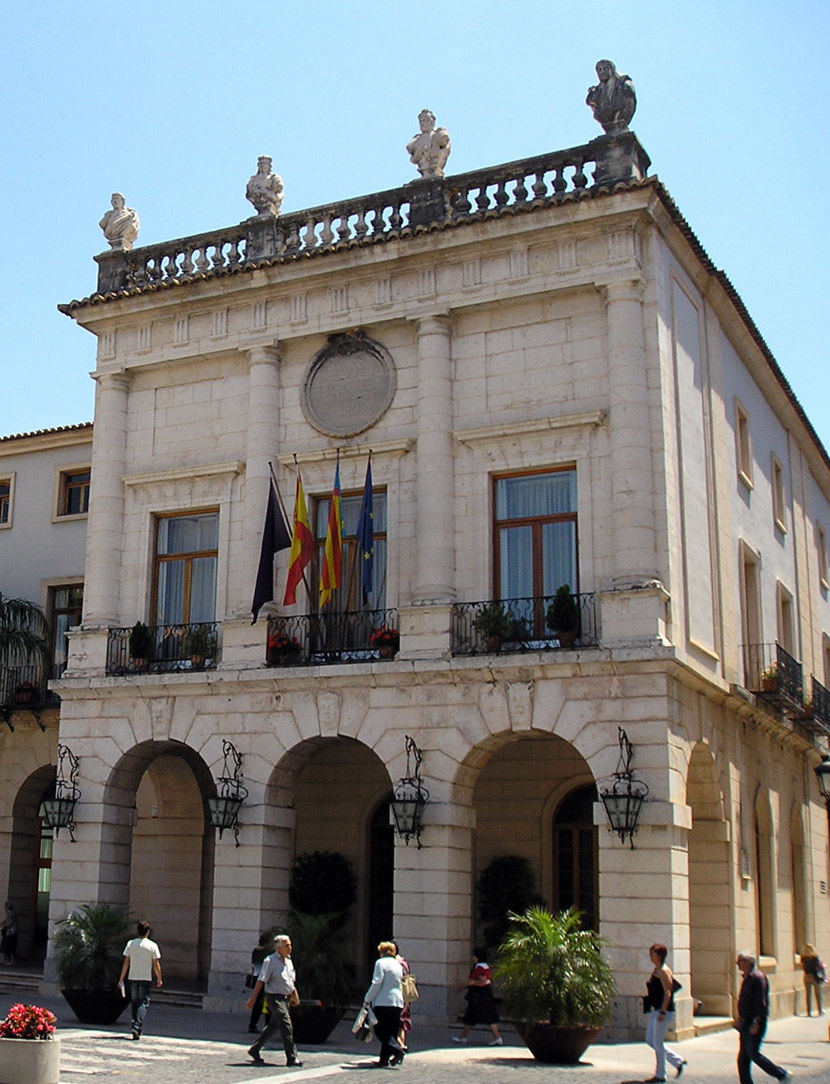
4.-Palau Ducal
It is the most outstanding and oldest building in the city, so it is worth mentionning in this audioguide. Structured around two courtyards, its interior deploys a range of styles that cover the centuries from the 14th up to the 20th. Property of the Jesuits since 1887, its interior can be viewed through guided tours. The tour starts at a virtual reality exhibit named “Espai de les Emocions”.
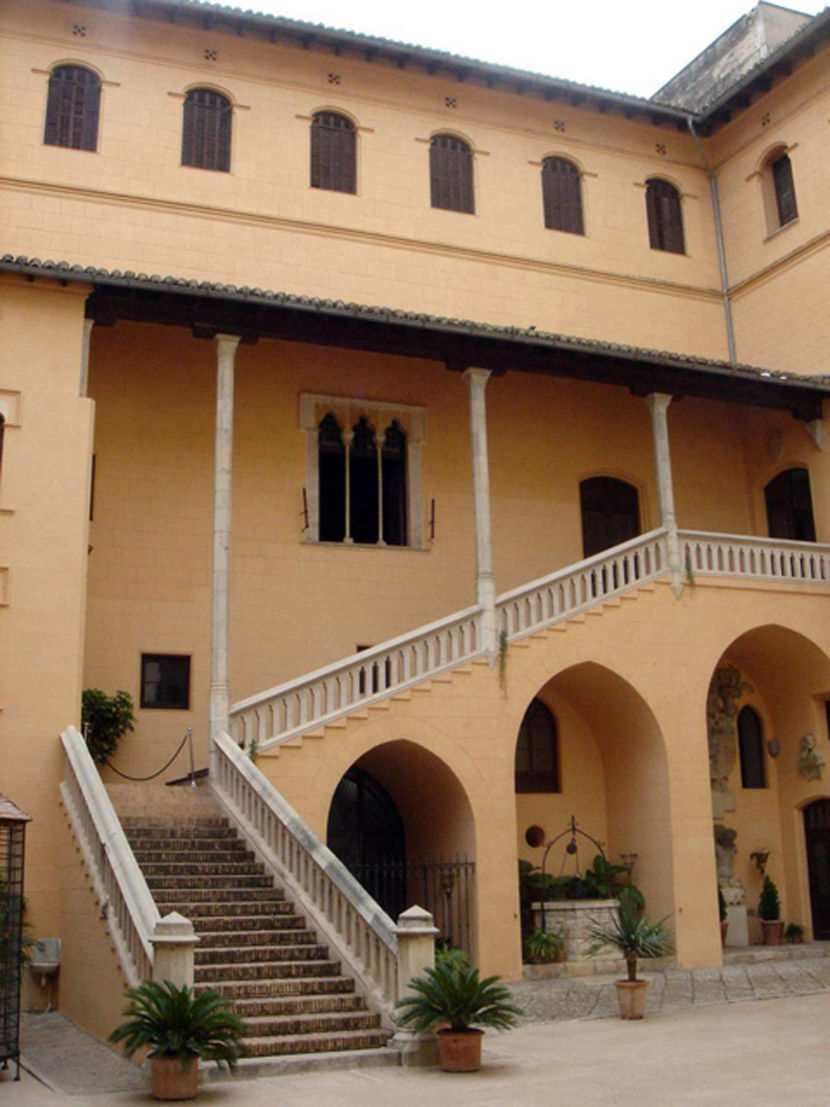
It is also known as the Palau dels Borja, because in 1485, when Pope Alexander VI bought the duchy of Gandia from Ferdinand the Catholic for his children, the palace became the residence of the new line of dukes. Its origins go back a century and a half earlier, to the era of the royal dukes of the Crown of Aragon.
• From the era of Alfons el Vell (14th and 15th c.) the entrance door with a round arch; the inside bolt with the four stripes of the Crown of Aragon, the arch to the courtyard; the top section of the main stairway and a gothic window from the 14th century stand out.
• The Salón de Coronas (Crown Room), in a sober Renaissance style, is the result of the reform by Francisco de Borja.
• The Sala de las Águilas was the main room.
• The Galería Dorada, in Rococo style, plays with the mirror effect and perspective. In this room, you can see the famous Four Elements mosaic.
• The Space of Emotions, located on the ground floor of the Palau, is a singular museum space, which prepares the visitor to visit the building and to understand the basic aspects of the history of Gandia. Visitors travel back in time through virtual reality, HD films and interactive projections, which show Gandia in the Golden Age of Valencia arts and the Era of the Borgias.
5.-Sant Marc Hospital - MAGA
This institution carried out its activity without interruption for over 600 years, from the 14th century until 1973. It currently houses the Archaeological Museum of Gandia (MAGA) and the Santa Clara Museum, that you can visit with the audioguide.
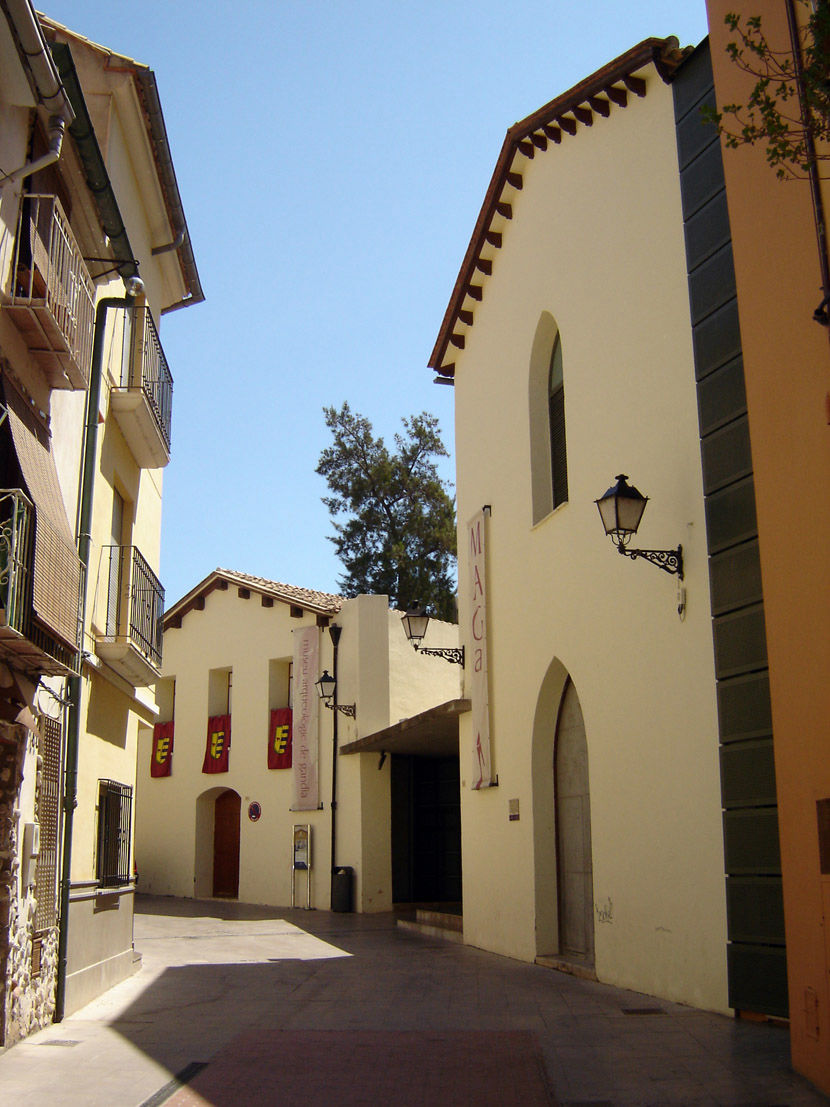
The architectural features that stand out are the Sala d’Hòmens (men’s ward), with round gothic style arches and the domed ceilings of the Sala de Dones (women’s ward).
The Archaeological Museum of Gandia (MAGa) has a permanent exhibition that not only shows the archaeological significance of Safor. It also covers the pre-history.
The Santa Clara Museum. This new museum hosts part of the artistic jewels that the Franciscan nuns have preserved. Three panels painted by Paolo da Sanleocadio stand out.
6.-Santa Clara Convent
The next place of this audioguide is a cloister inhabited by Franciscan nuns. The Romanesque door with a round arch leads to one of the most influential convents in Spain for centuries.
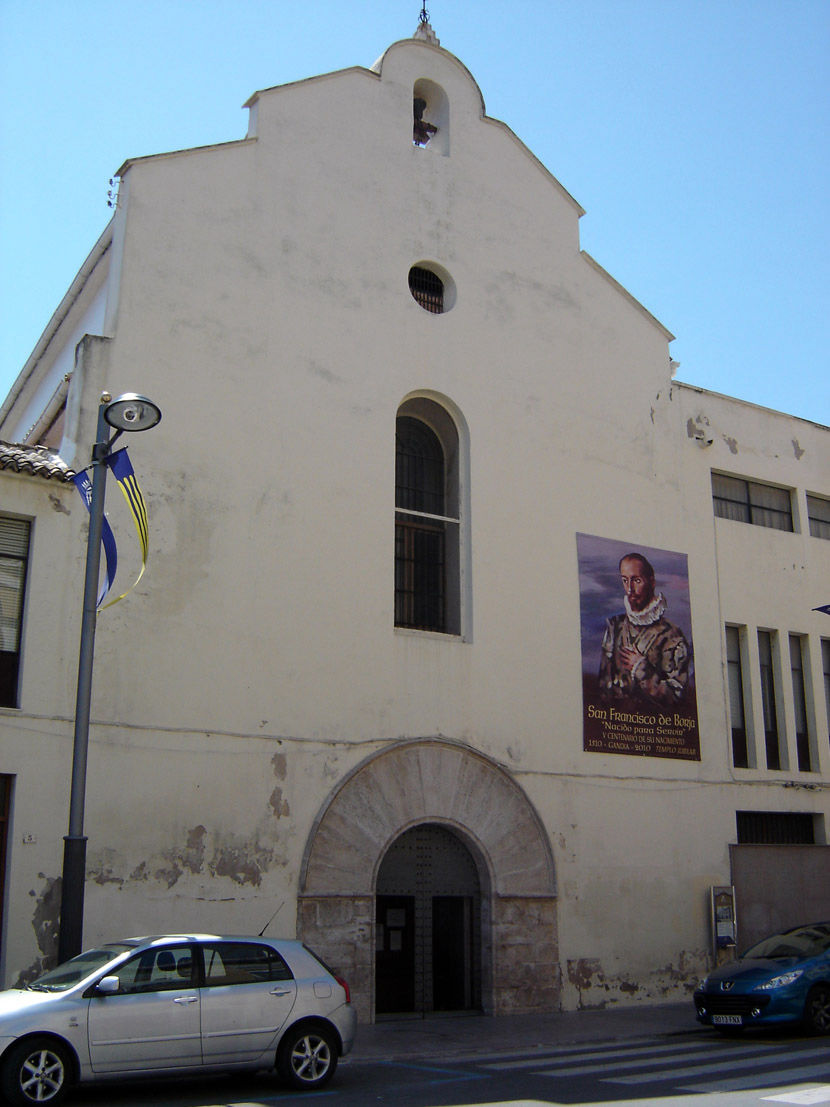
It was founded in 1429 by Violant d’Aragó, daughter of the royal duke Alfons el Vell. The convent took in several young people from the local nobility and, with the arrival of the Borgias in the 16th century; it experienced its most active era.
Santa Clara and the Borgias: Women of noble lineage, if they did not marry members of other powerful families or were appointed as ladies in waiting to queens or empresses, were destined for the cloister of Santa Clara of Gandia. The majority of young Borgias (and also adult widows) not only lived and died among these walls, but also contributed to founding important convents across the peninsula, such as the convents of Las Descalzas Reales in Madrid.
7.-Walls
To view these remains with the audioguide, it is advisable to cross the Pasarela bridge over the river Serpis. If you continue going straight ahead over the bridge, you reach Parc d’Ausiàs Marc, a lovely urban garden. On Saturdays, this park hosts the traditional weekly market.
Until 1881, the entire city was protected by walls. Of these, a bastion and part of the 14th century wall next to the river Serpis remain. In the 16th century, Saint Francisco de Borja ordered to build a new walled part. Of it, a tower named “Torreó del Pi” remains.
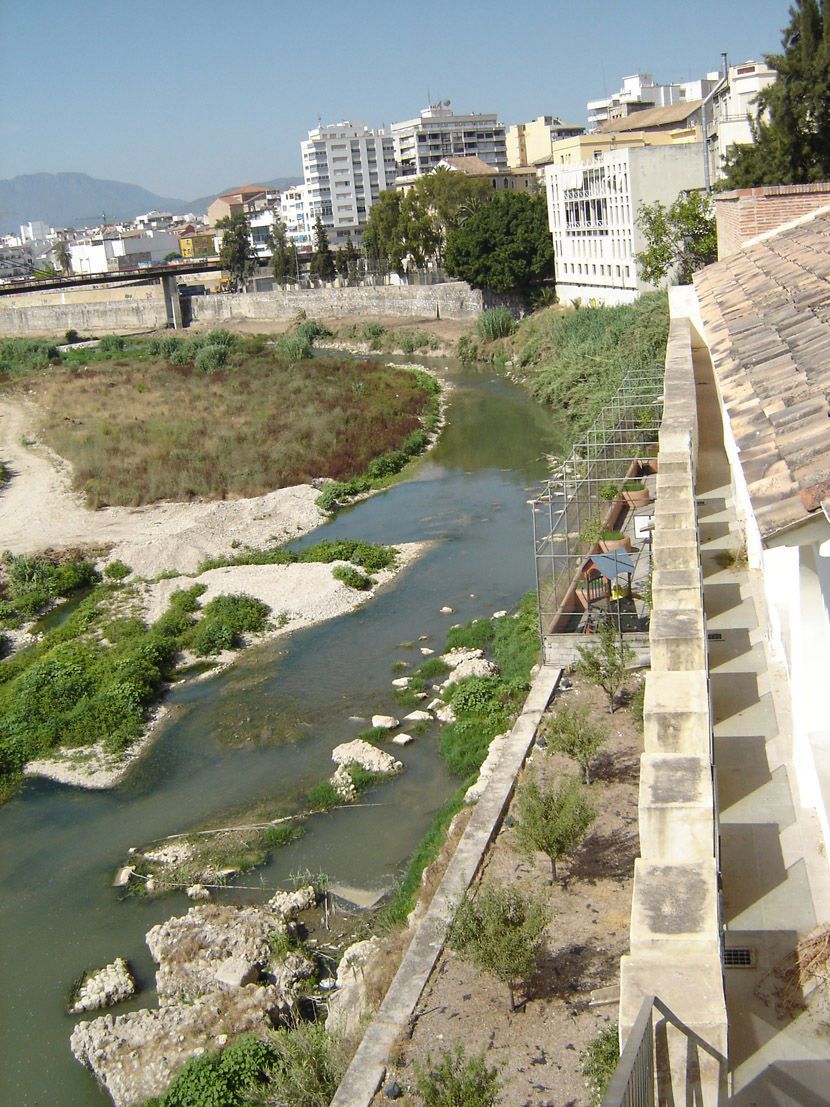
8.-Passeig de les Germanies
So called in memory of the Revolt of the Brotherhoods, an artisan revolt against the nobles, which around 1520 had significant consequences for Gandia and the Kingdom of Valencia.
The street crosses the city from east to west. It is part of the enlargement of the city from the 19th century, built after the walls were demolished.
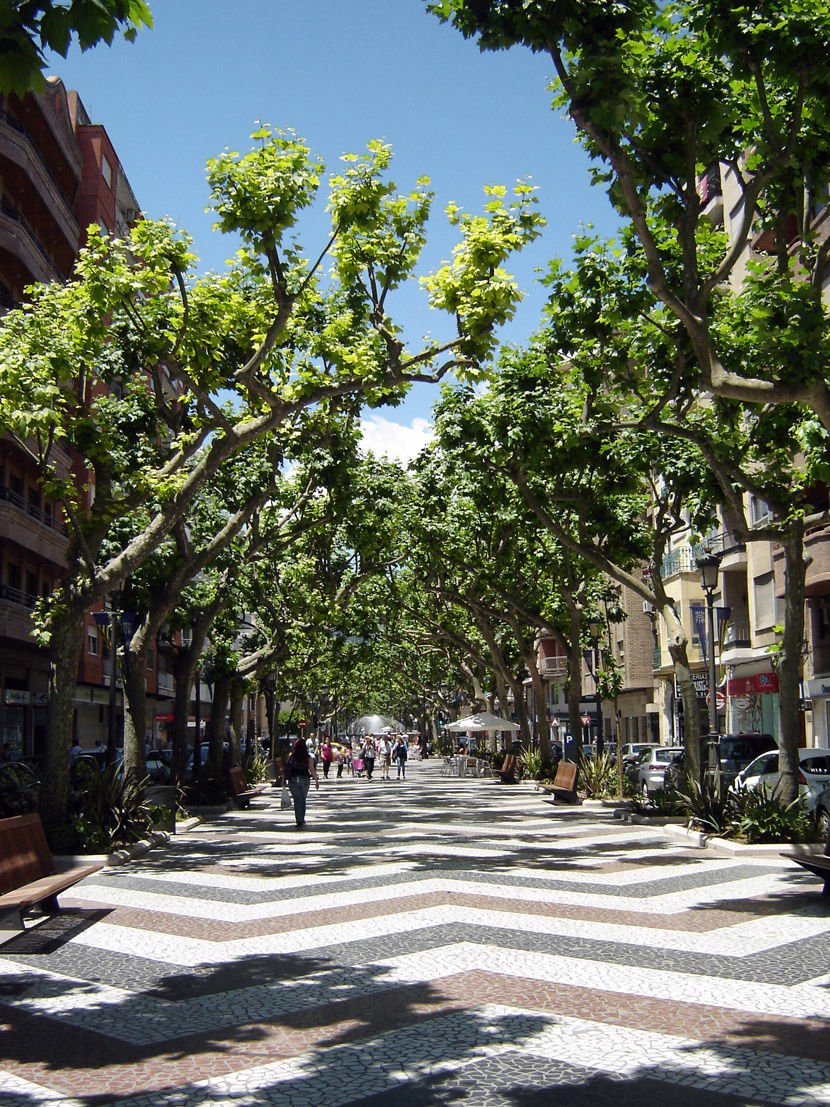
9.-El Raval
Next section of this audioguide, it was the neighbourhood where the Muslims lived until their expulsion from Spain in 1609.
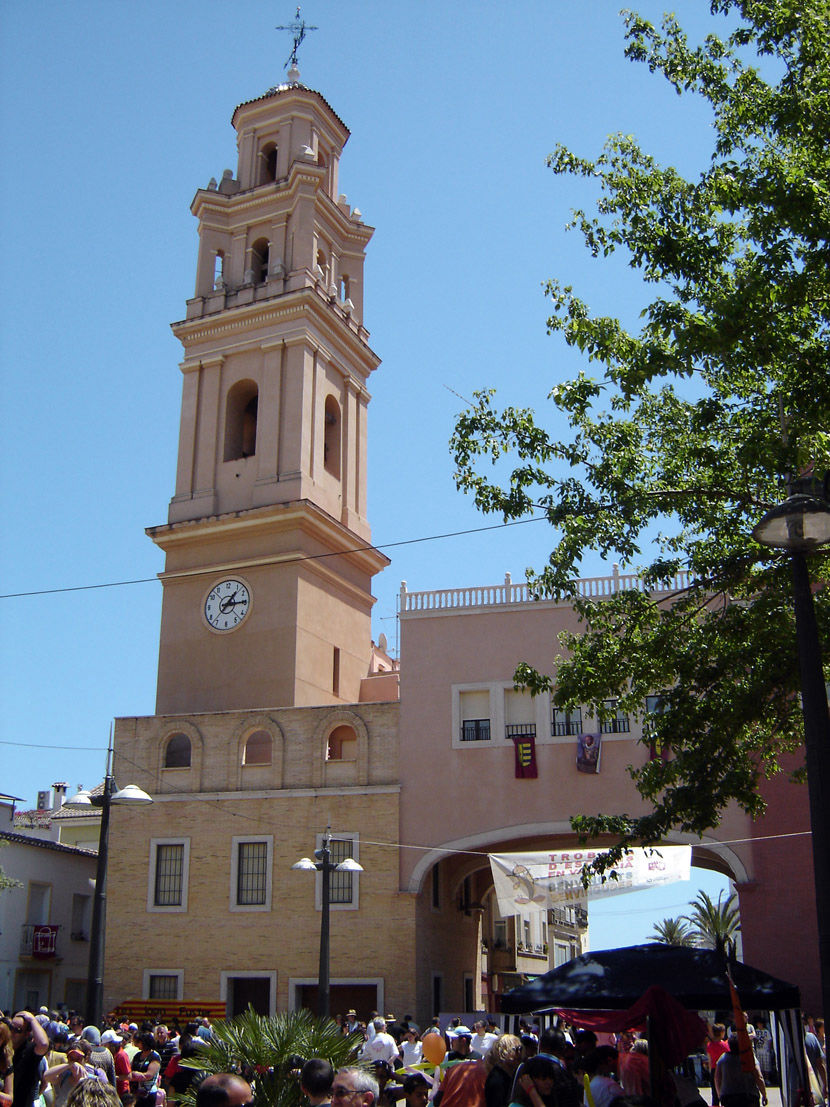
It was the neighbourhood where the Muslims lived (called mudéjares whilst they maintained their religion and Moriscos after being forcedly baptised during the Revolt of the Brotherhoods). The Church of Sant Josep was built on an old Muslim mosque.
10.-Plaça del Prado
Nowadays, it is a play area for children and houses restaurants and taverns where you can eat tapas and try traditional dishes with your audioguide. In the road Fundació Vicente Ferrer you can visit the modern art gallery Espai d’Art.
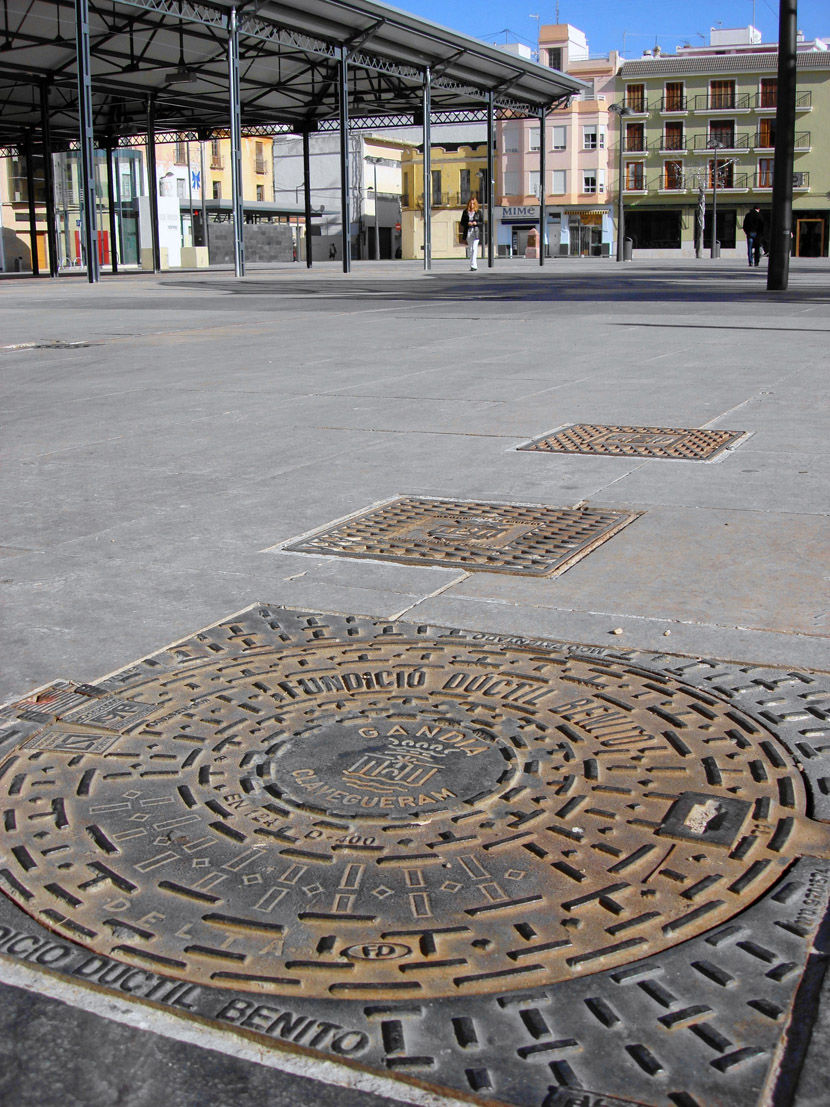
Next to El Raval is the Plaça del Prado, a large esplanade opened at the end of the 19th century, where for decades the wholesale food market was located.
11.-Cultural Centre.
This palace now houses the Casa de Cultura Marqués González de Quirós (Cultural Centre) and the Summer University of Gandia. It offers a stable cultural programme all year round. Many talks, debates and concerts are organised here. One of the attractions of Gandia in the summer is to listen to live music in the Concerts a la Marquesa.
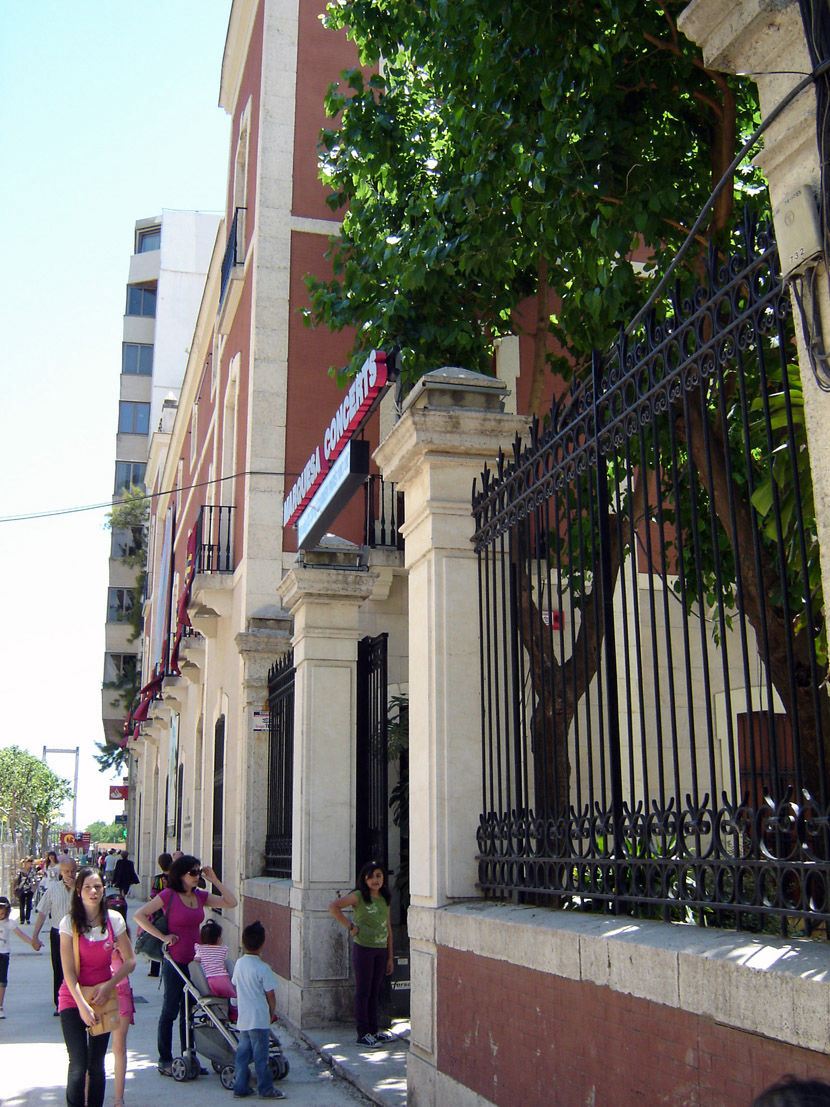
This small palace you can see with the audioguide was erected at the end of the 19th century by one of the most noteworthy and richest families, the Vallier Lapeyres. Originally from France, they settled in Gandia to trade in the silk produced in the city. www.gandiacultura.org
12.-Serrano Theatre
Its two halls allow stable scheduling all year round: theatre, concerts, Spanish operetta, dance, cinema, etc.
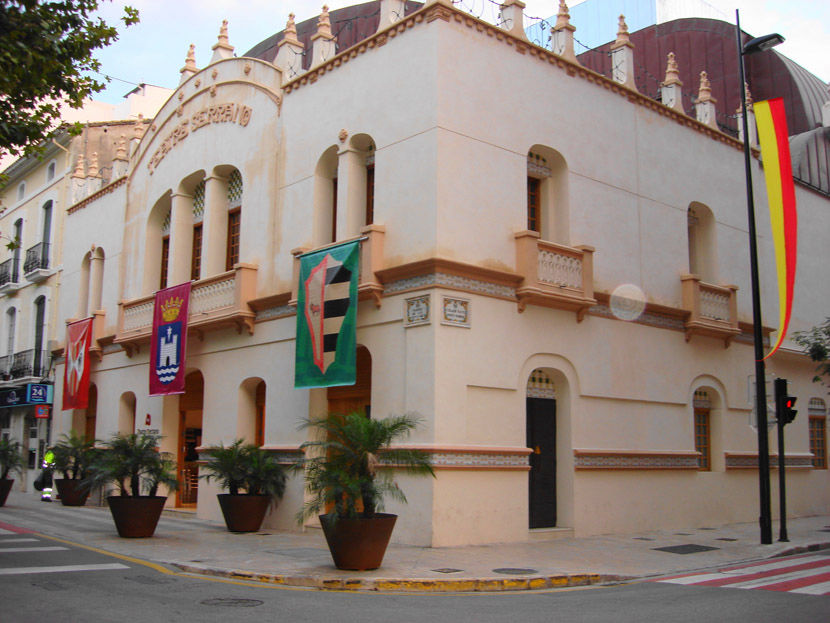
Its modern facade was erected in 1921 and its interior has been completely rebuilt to adapt to new staging needs.
13.-Sant Roc monastery
It is currently the home of the Central Library and the Historical Archive of Gandia.
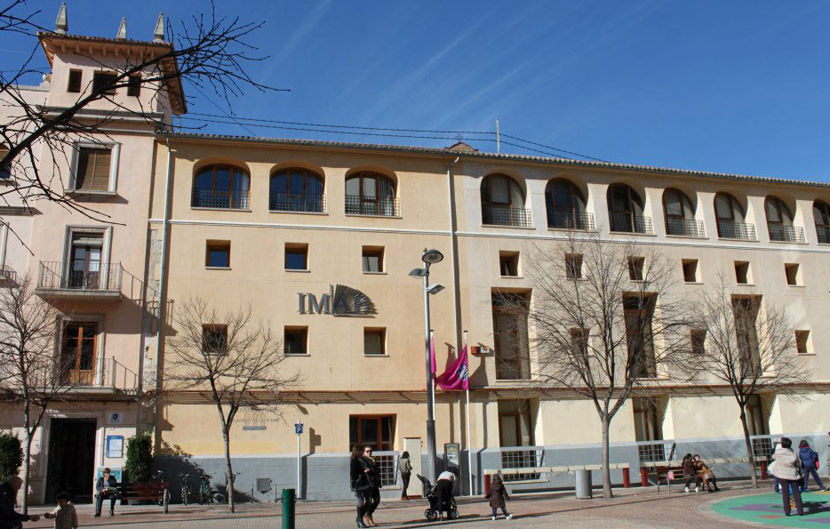
Founded in 1588 by the fifth duke, Carlos de Borja, son of Saint Francisco, it housed a community of discalced Franciscan monks, including the Beato Andrés Hibernón. The small cloister stands out, with two storeys and very simple, following the Franciscan rules. In the cloister there is a cafe, where you can read under the branches of orange trees or listen to the audioguide. The church was added to the convent in the 18th century.
14.-Museo Fallero
The MuseoFallero (Museum of Las Fallas), reproduces the sensations of the Fallas, through modern multimedia technologies. If travellers visit the city during other times of the year, they can live the festival in the Museo Fallero (Museum of Las Fallas). www.museufaller.org
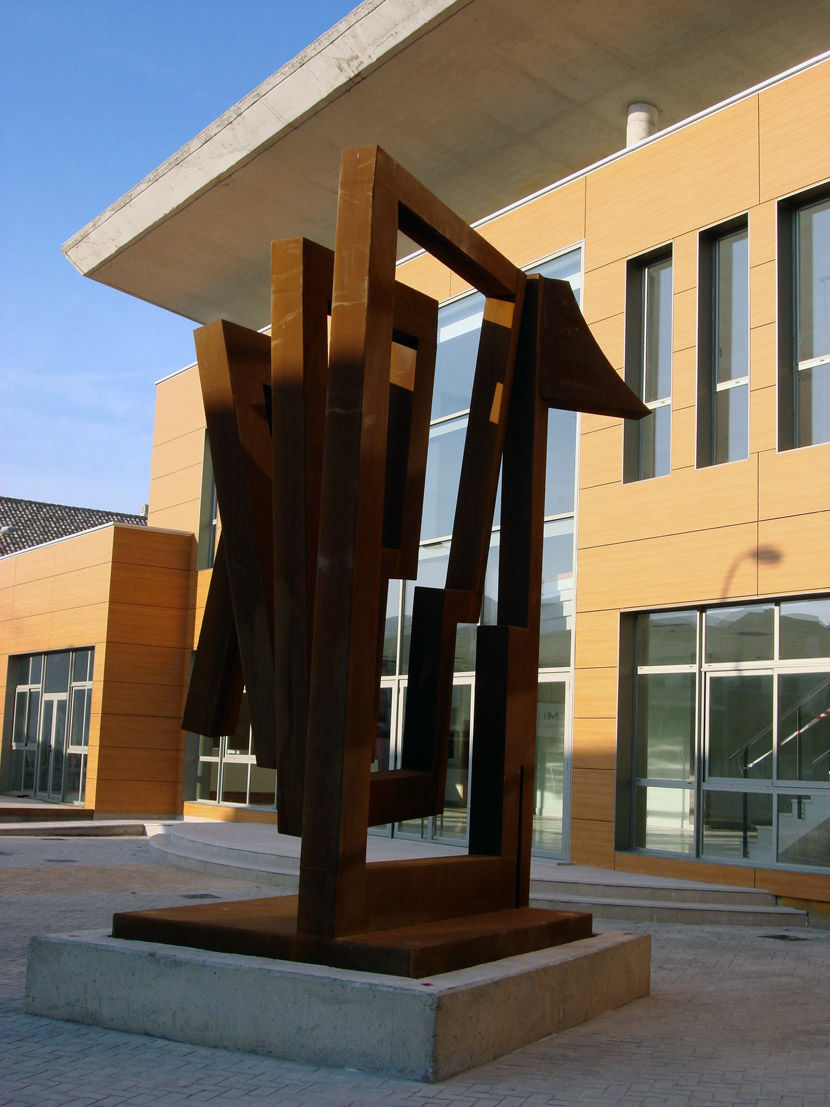
15.-Alquería del Duc
Next stop of this audioguide, it is located at the foot of Bairén castle, surrounded by orange trees and in the middle of the marshes. It now houses the Tourist Development Centre (CdT), the Spanish Wetlands Centre) and the Aula de la Natura visitor centre.
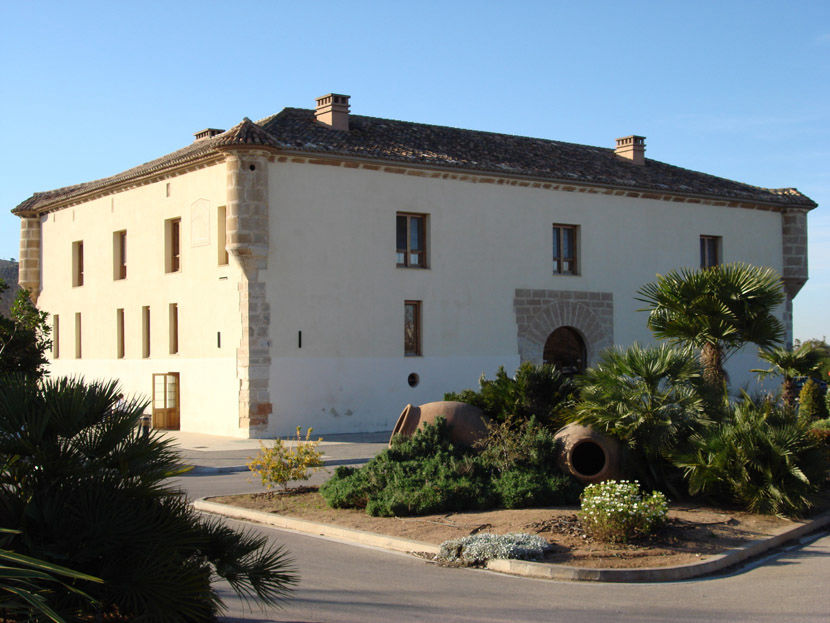
It is a 16th century fortified building. In 1590, the youngest son of San Francisco de Borja, Alfonso de Borja y Castro, bought it and converted it into a recreation and hunting manor.
Near is the Ullal de l’Estany, an example of the biodiversity of the marshes and coastal wetlands that can be visited during all along the year. www.aulanaturagandia.es
16.-El Grau, the port and the beach
• El Grau, is the ’fishermen’s neighbourhood. It forms a type of estuary. At one side there is the port. At the other side the church of Sant Nicolau, the Yacht Club and the break-water.
• The warehouses or tinglados in the port were built in the 1930s. They form a harmonious group of twelve domed warehouses, with the Torre Del Rellotge (clock tower) in the centre.
• The beach: is now Gandia’s biggest tourist attraction, with a total length of 7 kilometres. The Platja Nord, with its long promenade, underground car park and its cycle lane, is very pleasant any time of the year. To the north is the Platja de l’Auir, one of the few virgin beaches left on the Valencia coast. There is a nudist beach, which is signposted. South of the port are the beaches of Rafalcaid and Venècia that you can reach with the audioguide.
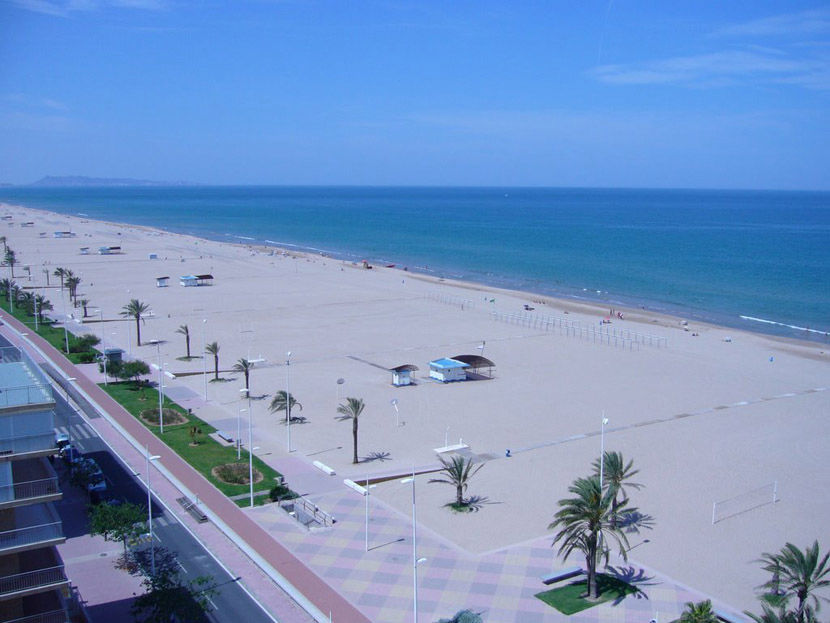
Although El Grau has existed since medieval times, with the growth of the citrus sector and industrial growth in the city of Alcoi at the end of the 19th century the new port was inaugurated and in 1893, the Gandia-Alcoi railway was built with English capital. This train ran until 1969 Through the export of oranges, the port of Gandia became one of the most important sources of currencies in Spain in the 1950s and 1960s.
FESTIVALS
The Falles
Worth mentionning in this audioguide, the Falles is Gandia’s most popular festival. From 16 to 19 March, in each neighbourhood, a monument with ninots (dolls) made of papier-mâché is built, which sum up and satirize current events. Thousands of inhabitants walk through the city to the sound of music bands, dressed in costumes from the 18th century. Fireworks and bonfires are the leading attractions in the bright festival, which ends with the Nit de la cremà, when dozens of bonfires burn in the city, lighting up the night of the 19th March.
Easter
Thousands of people take part in the different cofradías (brotherhoods) or Easter processions, which have been held in Gandia since the end of the 19th century, although their origins are medieval, and have been declared of National Tourist Interest.
• La Visitatio Sepulchri: This is the most authentic Easter event in Gandia. It is a liturgical drama set up in 1550 by San Francisco de Borja, when he was already a Jesuit and before leaving for Rome.
• Corpus Christi: The Corpus Christi festival, has been held in Gandia since at least 1391. The parade is preceded by a series of dances and medieval characters, such as giants and cabezudos (figures with huge heads), els Arquets, la Magrana and la Moma.
Nit de Sant Joan
The night of the 23 to 24 June, at midnight, thousands of people go to the beach and light bonfires on the sand. Jumping over the embers and the waves of the sea making a wish are part of the ritual of this magical night.
La Fira i Festes
In the days running up to 3 October, Fira i Festes is held in honour of the patron of Gandia, Saint Francis Borgia. The origin of Fira (fair) goes back to 1310. The modern fair attractions have replaced the medieval market, and the events are organised by the Town may with the collaboration of various civic associations.
• El Tio de la Porra: A unique local character is Tio de la Porra, who goes around the city with his band of drummers, going from school to school to get the children out on the street, to the great joy of them all.
• El Cant de la Sibil-la: On the night of Christmas Eve, a religious play from the 13th century is performed at the hermitage of Santa Anna. The play is a child dressed in white plays the part of a Sibyl or Roman prophetess who announced Judgement Day.
Bluehertz Audio guides has developed for Gandia´s town hall an audio guide service available in Spanish, Valencian, English and French languages.
Gandia´s Tourist Office address: Av. Marqués de Campo s/n 46701 Gandia, Valencia.
- Tel.: 96 287 77 88 - www.visitgandia.com - gandia@touristinfo.net -
Back to index